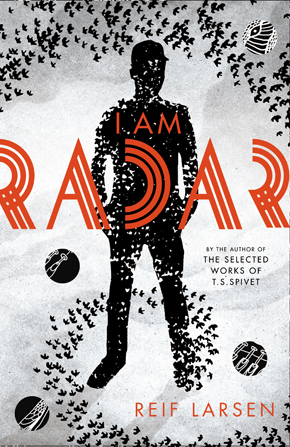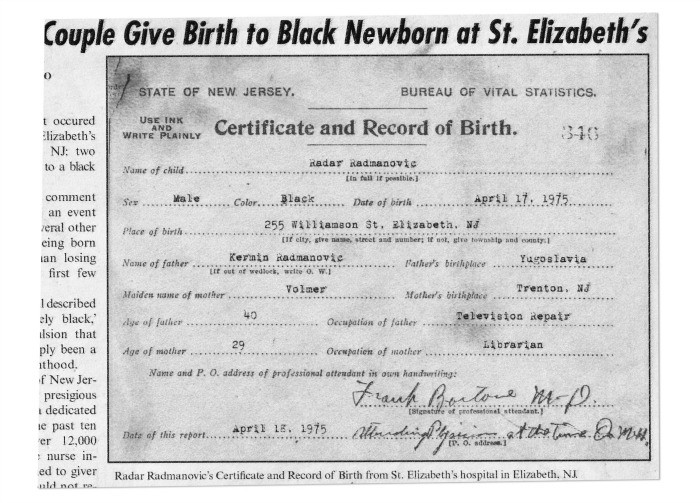Enter Radar
by Reif Larsen
“Big, beautiful, ambitious… His prose is addictive and enchanting.” Los Angeles Times
The birth of such an extremely dark baby (described as “blacker than the blackest black” by an overeager Star-Ledger reporter) to two white parents was Jersey gossip that could not be kept quiet for long. The news of the birth must have been leaked by one of the orderlies, or one of the janitors, or perhaps even the nurse who had typed up the certificate of birth. Someone had talked to someone who had talked to someone, and suddenly there was a small group of reporters wandering around the maternity ward the next morning asking questions to anyone who would listen: You’re telling me this wasn’t just a mix-up, right? The kid could be from another family… No? Okay, well, had the mother slept around? All right, all right. Fair enough. So then what was wrong with him? Okay, but what do you call that kind of thing? Was it a disease? What were the chances of this kind of thing happening? Yeah, but ballpark: one in a million? One in a billion? How black was he really? That black? Like Nigerian black? So then, when can we see him? What do you mean? Well, come on now, that’s a load of horseshit.
The day after his birth, the Newark Star-Ledger ran a front-page article with the relatively modest headline “Caucasian Couple Give Birth to Black Newborn at St. Elizabeth’s.” Lacking a serviceable photograph, they settled for a poorly rendered xerox of Radar’s birth certificate, as if this was all the proof anyone could need. Across the Hudson, the New York Post declared, “Jersey Freak of Nature: White Parents… Black Baby!” and then proceeded to give very few details elaborating on their inflammatory headline. Baby Radar, caught in a genealogical conundrum not of his choosing, had suddenly become a cultural touchstone.
Perhaps all of the fuss was due to the alchemy of that particular time and place: eight years removed from the ’67 Newark riots, urban white flight was now in full swing. The manufacturing industry was steadily collapsing, leaving New Jersey in the throes of a severe recession. People – both white and black alike – were struggling to come to terms with the great expectations laid forth by the civil rights movement of the previous decade. How would such lofty ideals play out in the banal commerce of the everyday? Had everything changed? Or, as many were slowly realizing, had nothing really changed at all?
 No doubt the story also gained traction because the simplest and most obvious explanation for Radar’s appearance, the explanation that spawned a thousand breakfast table jokes – a.k.a. ‘the milkman theory’ – ultimately proved inadequate, given the child’s coloring. If the people could only have gotten a good look at the baby, they would have understood, once and for all, that mere infidelity could not possibly have triggered such a dramatic swing in color from the whitest of whites to ‘the blackest of blacks’. And yet the people could not get a good look at Radar Radmanovic, because there were no photos of him save a (supposed) shot of his incubator, taken from some distance. With such scant evidence, the public was left to wonder on their own about the nature of inheritance, about what was passed down to a child and what was not, about the chances of such a highly unusual genetic occurrence – if it was indeed a genetic occurrence – ever happening to one of their own children. In the midst of all this, the family remained secretive, declining all interviews, shunning photographers, despite rumors of several five-figure offers for an exclusive photo shoot and rights to their story.
No doubt the story also gained traction because the simplest and most obvious explanation for Radar’s appearance, the explanation that spawned a thousand breakfast table jokes – a.k.a. ‘the milkman theory’ – ultimately proved inadequate, given the child’s coloring. If the people could only have gotten a good look at the baby, they would have understood, once and for all, that mere infidelity could not possibly have triggered such a dramatic swing in color from the whitest of whites to ‘the blackest of blacks’. And yet the people could not get a good look at Radar Radmanovic, because there were no photos of him save a (supposed) shot of his incubator, taken from some distance. With such scant evidence, the public was left to wonder on their own about the nature of inheritance, about what was passed down to a child and what was not, about the chances of such a highly unusual genetic occurrence – if it was indeed a genetic occurrence – ever happening to one of their own children. In the midst of all this, the family remained secretive, declining all interviews, shunning photographers, despite rumors of several five-figure offers for an exclusive photo shoot and rights to their story.
Theories ranged from a rare double-recessive melanism gene expression (‘A distant black ancestor come to life!’) to toxic waste exposure (‘The child was a mutant!’)”
On one of the morning talk radio shows, a then relatively unknown Reverend Jesse Louis Jackson, who was about to embark on the famous ten-day tour of apartheid South Africa that would subsequently springboard him into the international spotlight, weighed in on the case, admonishing the media for implicitly accusing “the black male scapegoat of raping another one of its white women.”
“This,” he said emphatically, “is an act of God, not of one man. This child is blessed. I hope the family realizes just how lucky they are.” Radar’s story lingered in the Jersey tabloids for only a week or so. Various medical professionals and semi-professionals were called in to offer half-baked theories for what might have happened to the baby – theories that ranged from a rare double-recessive melanism gene expression (“A distant black ancestor come to life!”) to toxic waste exposure from one of New Jersey’s many Meadowlands industrial sewage dumps (“The child was a mutant!”). After this initial flurry of coverage, however, the story, like all stories, shriveled up and eventually disappeared, and Radar and his condition would not be heard of again until nearly four years later, when Dr. Thomas K. Fitzgerald would deliver his much-anticipated diagnosis, “On an Isolated Incidence of Non-Addison’s Hypoadrenal Uniform Hyperpigmentation in a Caucasian Male,” in the Journal of Investigative Dermatology.
…
A week of intensive tests confirmed that everything else with Radar, save his unlikely hue, was more or less normal. A couple of the results were slightly worrisome: the iron content in his blood was elevated, as were his cortisol levels, though neither of these was unusual for newborns recovering from the hormonal starburst of birthing and the violent adjustment to a new world of oxygen and sunlight. Baby Radar also exhibited slightly higher-than-normal blood pressure and suffered from moderately dry skin that required treatment with a prescription lotion. But nothing so out of the ordinary as to point to a cause for his unusual appearance. His hair, present from birth, was soft and black and straight, just like his father’s. Indeed, if you could look past his darkness, Radar perfectly resembled a little Kermin: there was the same dimpled chin, the same funicular jawline, the same protrusive brow. If not for their diametric coloring, there would be no question of their relation.
This is an edited extract from I Am Radar.
 Reif Larsen is the author of The Selected Works of T.S. Spivet, which was shortlisted for the Guardian First Book Award and the James Tait Black Memorial Prize, and has now been made into a film by Jean-Pierre Jeuent, the director of Amélie. He studied at Brown University and has taught at Columbia University. His essays and fiction have appeared in the New York Times, the Guardian, Tin House, Asymptote, The Millions and The Believer. He currently lives in Scotland and holds the International Writers’ Residency at the University of St Andrews. I Am Radar is published in hardback by Harvill Secker and in eBook by Vintage Digital. Read more.
Reif Larsen is the author of The Selected Works of T.S. Spivet, which was shortlisted for the Guardian First Book Award and the James Tait Black Memorial Prize, and has now been made into a film by Jean-Pierre Jeuent, the director of Amélie. He studied at Brown University and has taught at Columbia University. His essays and fiction have appeared in the New York Times, the Guardian, Tin House, Asymptote, The Millions and The Believer. He currently lives in Scotland and holds the International Writers’ Residency at the University of St Andrews. I Am Radar is published in hardback by Harvill Secker and in eBook by Vintage Digital. Read more.
iamradar.net
Author portrait © Mark Vessey
Saturday 18 April
 Reif Larsen in conversation with Tom McCarthy
Reif Larsen in conversation with Tom McCarthy
Mitchell Library, North Street, Glasgow G3 7DN
4:30 to 5:30 pm
£9
Join two of the boldest and most distinctive voices in contemporary fiction as they discuss their latest work.
Chaired by Stuart Kelly.
More info

